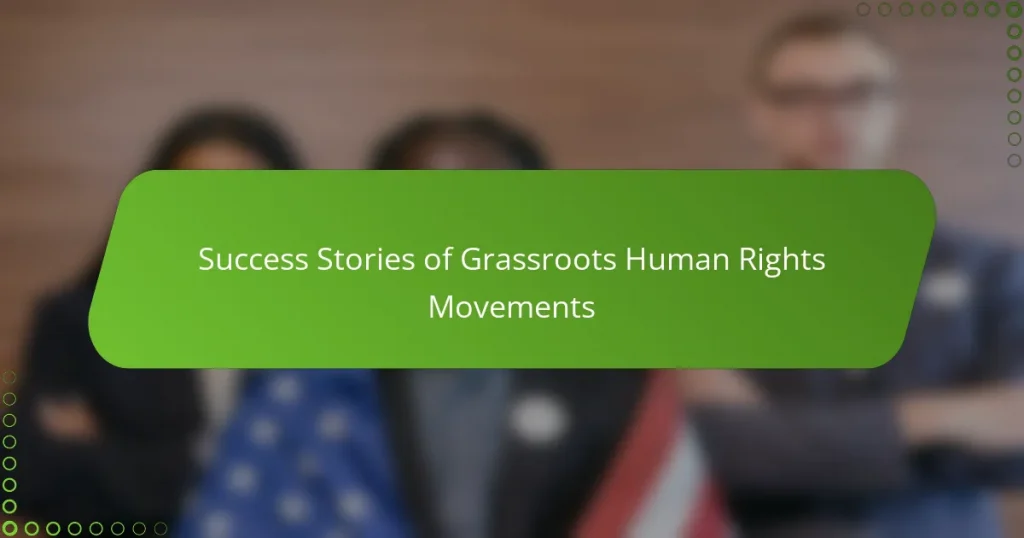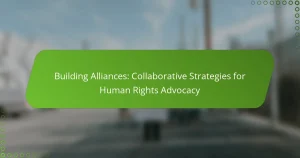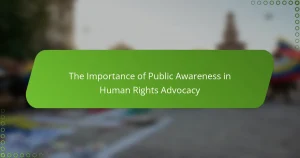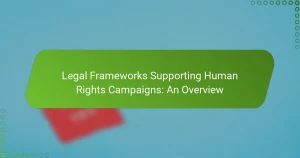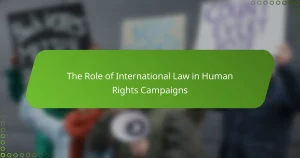Grassroots human rights movements are community-driven initiatives focused on advocating for and protecting human rights, often arising from local populations facing injustices. This article examines the success stories of such movements, highlighting key factors that contribute to their effectiveness, including community engagement, effective leadership, and strategic alliances. It discusses historical examples like the Civil Rights Movement in the United States and the anti-apartheid movement in South Africa, illustrating how these movements have influenced legislation and societal norms. Additionally, the role of storytelling and social media in amplifying their messages and the importance of consistent advocacy for achieving long-term goals are explored.
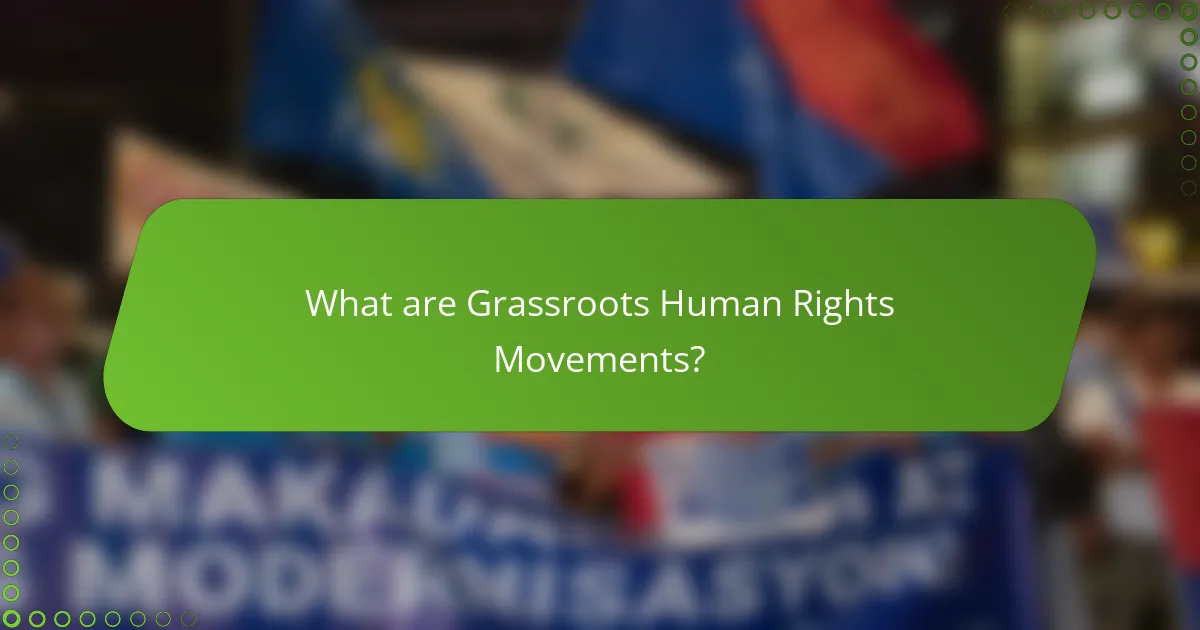
What are Grassroots Human Rights Movements?
Grassroots human rights movements are community-driven initiatives aimed at advocating for and protecting human rights. These movements often emerge from local populations facing injustices. They mobilize individuals to raise awareness and demand change. Grassroots movements focus on issues like racial equality, gender rights, and environmental justice. They operate outside of formal political structures. Historical examples include the Civil Rights Movement in the United States and the anti-apartheid movement in South Africa. These movements have successfully influenced legislation and societal norms. Their impact demonstrates the power of collective action in promoting human rights.
How do Grassroots Human Rights Movements emerge?
Grassroots human rights movements emerge from community mobilization around shared injustices. These movements typically begin when individuals recognize violations of their rights or the rights of others. Awareness often arises through personal experiences or collective grievances. Local leaders or activists usually play a crucial role in organizing efforts. They rally support and create networks for advocacy. Social media and technology often amplify their voices and reach wider audiences. Historical contexts, such as oppression or discrimination, can catalyze these movements. For example, the Civil Rights Movement in the United States began in response to systemic racism and inequality.
What social conditions foster the growth of these movements?
Social conditions that foster the growth of grassroots human rights movements include widespread social injustice and inequality. High levels of discrimination can mobilize marginalized communities. Economic hardship often leads to increased activism as people seek change. Political repression can also drive movements, as citizens push back against authoritarian regimes. Access to education raises awareness about rights and mobilizes individuals. Social media serves as a tool for organizing and spreading messages. Historical precedents of successful movements inspire current activism. These conditions create an environment ripe for collective action and advocacy.
What role do local communities play in these movements?
Local communities are essential in grassroots human rights movements. They provide grassroots support, mobilizing individuals for advocacy and awareness. Community members often share personal experiences that highlight human rights issues. This local perspective fosters empathy and urgency for change. Local organizations facilitate direct action and resource allocation. They also build networks that connect activists and amplify voices. Historical examples include the Civil Rights Movement, where local communities played a pivotal role in protests and voter registration drives. Such involvement is crucial for sustaining momentum and achieving tangible outcomes.
Why are Grassroots Human Rights Movements important?
Grassroots human rights movements are important because they empower communities to advocate for their rights. These movements often emerge from local needs and experiences, making them highly relevant and effective. They mobilize individuals to challenge injustices and promote social change. Historical examples include the Civil Rights Movement in the United States, which significantly advanced racial equality. Additionally, grassroots movements often operate with limited resources, showcasing the power of collective action. They can influence policy changes and raise awareness on critical issues. Their localized approach fosters accountability and ensures that marginalized voices are heard.
How do they contribute to societal change?
Grassroots human rights movements contribute to societal change by mobilizing communities to advocate for justice. They raise awareness about human rights violations and empower individuals to take action. These movements often highlight issues that are overlooked by mainstream media and government. For example, the Civil Rights Movement in the United States led to significant legislative changes. It resulted in the Civil Rights Act of 1964 and the Voting Rights Act of 1965. Similarly, movements like Black Lives Matter have sparked global conversations about racial inequality. They encourage public discourse and policy reform. Through protests, education, and community organizing, grassroots movements create lasting impact. Their efforts often lead to increased civic engagement and social accountability.
What impact do they have on policy and legislation?
Grassroots human rights movements significantly influence policy and legislation. They raise awareness about social injustices and mobilize public opinion. This collective action can lead to legislative changes that address human rights violations. For example, the Civil Rights Movement in the United States led to the Civil Rights Act of 1964. Similarly, the [censured] rights movement has resulted in the legalization of same-[censured] marriage in many countries. These movements often engage in lobbying efforts to advocate for specific laws. They also utilize social media to amplify their messages and reach wider audiences. As a result, grassroots movements can shift political priorities and compel governments to act.
What are some notable examples of successful Grassroots Human Rights Movements?
Notable examples of successful grassroots human rights movements include the Civil Rights Movement in the United States. This movement aimed to end racial segregation and discrimination against African Americans. Key figures like Martin Luther King Jr. led peaceful protests and marches. Their efforts resulted in the Civil Rights Act of 1964 and the Voting Rights Act of 1965.
Another example is the anti-apartheid movement in South Africa. This movement sought to dismantle the system of racial segregation enforced by the apartheid regime. Leaders like Nelson Mandela mobilized international support and organized protests. The movement culminated in the end of apartheid in the early 1990s.
The Women’s Suffrage Movement is also significant. It fought for women’s right to vote in various countries. Activists like Susan B. Anthony and Emmeline Pankhurst played crucial roles. Their efforts led to the passage of voting rights for women in many nations.
These movements demonstrate the power of grassroots activism in achieving significant human rights advancements.
What strategies did these movements employ for success?
Grassroots human rights movements employed a variety of strategies for success. They utilized community organizing to mobilize individuals around common goals. These movements often focused on raising awareness through education and advocacy campaigns. They leveraged social media to amplify their messages and reach a broader audience. Building coalitions with other organizations enhanced their impact and resources. Nonviolent protests and demonstrations were common tactics to draw attention to their causes. Legal challenges were also employed to challenge unjust laws and policies. By engaging in dialogue with policymakers, they sought to influence legislation. These strategies collectively contributed to significant advancements in human rights protections.
How did they overcome challenges and obstacles?
Grassroots human rights movements overcame challenges and obstacles through community mobilization and strategic alliances. They engaged local communities to build support networks. Education and awareness campaigns were utilized to inform the public about human rights issues. Collaborations with NGOs and international organizations provided additional resources and visibility. Legal advocacy was employed to challenge unjust laws and practices. Grassroots leaders often adapted their strategies in response to repression. Persistence and resilience in the face of adversity were crucial for sustaining their efforts. These approaches led to significant policy changes and social impact, demonstrating the effectiveness of grassroots activism.
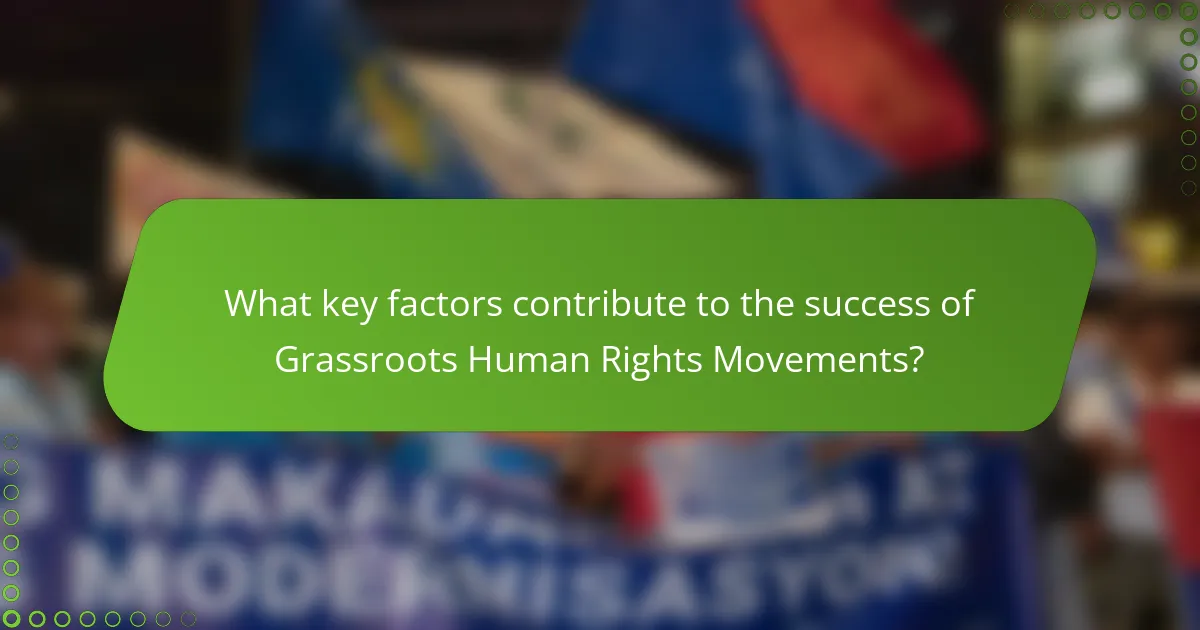
What key factors contribute to the success of Grassroots Human Rights Movements?
Key factors that contribute to the success of grassroots human rights movements include community engagement, effective leadership, and strategic alliances. Community engagement fosters a sense of ownership and commitment among members. Effective leadership provides vision and direction, inspiring action and mobilizing resources. Strategic alliances with other organizations amplify voices and broaden support networks. Additionally, clear messaging helps to communicate goals and attract attention. Historical examples, such as the Civil Rights Movement in the United States, demonstrate how these factors can lead to significant social change.
How does community engagement affect movement success?
Community engagement significantly enhances movement success. Engaged communities are more likely to mobilize resources and support. Active participation fosters a sense of ownership and commitment among members. This connection leads to increased visibility and awareness of the movement’s goals. For example, the Civil Rights Movement in the United States thrived due to widespread community involvement. Grassroots organizations that engaged local populations achieved greater impact and influence. Research shows that movements with strong community ties often see higher rates of participation and advocacy. This correlation underscores the importance of community engagement in achieving lasting change.
What methods are effective for mobilizing community support?
Effective methods for mobilizing community support include grassroots organizing, social media campaigns, and community engagement events. Grassroots organizing involves building local networks to foster relationships and trust. Social media campaigns can amplify messages quickly, reaching a broader audience. Community engagement events create opportunities for face-to-face interaction and collaboration. Research shows that these methods significantly increase participation and support. For instance, the 2017 Women’s March utilized social media to mobilize millions globally, demonstrating the power of these strategies.
How does grassroots leadership influence outcomes?
Grassroots leadership significantly influences outcomes by mobilizing community engagement and fostering local ownership. This type of leadership empowers individuals to advocate for their rights and interests. Grassroots leaders often possess deep knowledge of local issues, enabling them to address specific community needs effectively. They build trust and credibility among community members, which enhances collective action. Studies show that grassroots movements can lead to substantial policy changes. For example, the Civil Rights Movement in the United States resulted in landmark legislation, including the Civil Rights Act of 1964. This demonstrates the ability of grassroots leadership to achieve meaningful social change.
What role does social media play in these movements?
Social media plays a crucial role in grassroots human rights movements. It serves as a platform for awareness and mobilization. Activists use social media to share information rapidly. This includes updates on events, calls to action, and personal stories. Social media also facilitates global reach, connecting local movements to international audiences. For instance, the #BlackLivesMatter movement gained momentum through Twitter and Instagram. Research shows that social media can increase participation in protests. A study by the Pew Research Center found that 53% of social media users engage with social issues online. Overall, social media enhances visibility and fosters community among activists.
How has the digital age transformed grassroots activism?
The digital age has transformed grassroots activism by enhancing communication and mobilization capabilities. Social media platforms allow activists to reach larger audiences quickly. Online petitions can gather support in a matter of hours. Digital tools enable real-time updates and coordination during protests. Data analytics help identify key issues and target demographics effectively. Crowdfunding platforms provide financial support for grassroots initiatives. The accessibility of information empowers individuals to engage in activism. Overall, the digital landscape has made grassroots movements more dynamic and impactful.
What are the benefits and drawbacks of using social media?
Social media offers significant benefits and drawbacks. Benefits include increased awareness and mobilization for grassroots human rights movements. Platforms enable rapid dissemination of information. This facilitates community engagement and support. For example, the #BlackLivesMatter movement gained global traction through social media. Drawbacks include misinformation and polarization. False narratives can spread quickly, undermining legitimate causes. Additionally, social media can create echo chambers. These limit exposure to diverse perspectives. Overall, while social media can empower movements, it also poses risks that need to be managed.
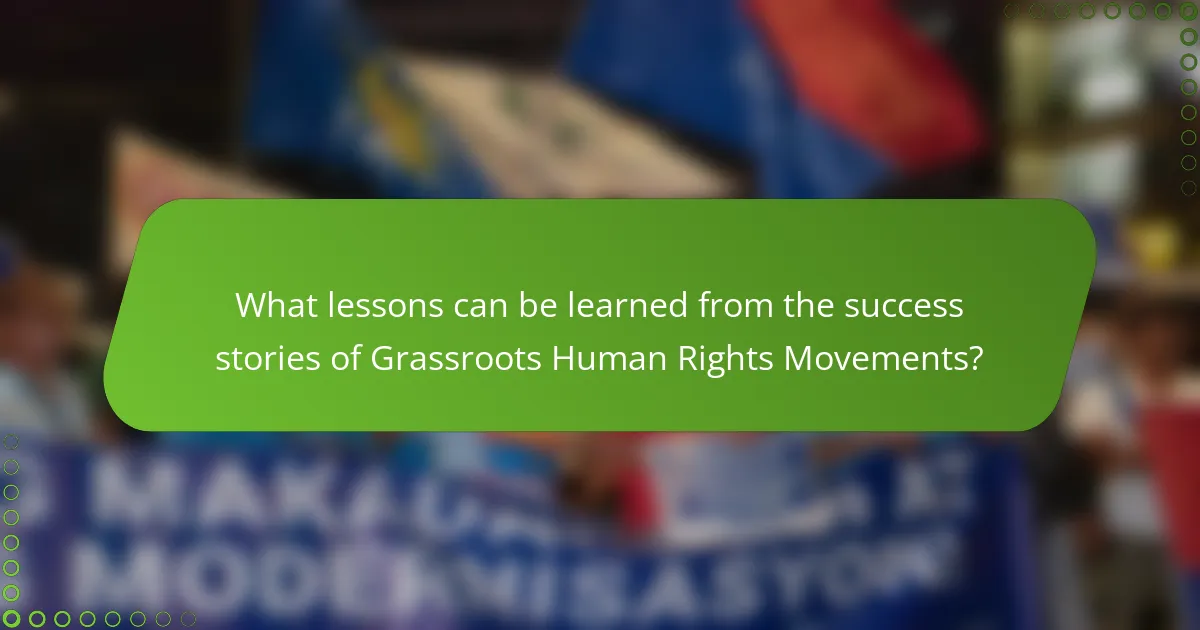
What lessons can be learned from the success stories of Grassroots Human Rights Movements?
Grassroots human rights movements demonstrate the power of community organization and collective action. These movements often succeed by mobilizing local populations around shared goals. They highlight the importance of grassroots leadership in advocating for change. Successful movements utilize storytelling to raise awareness and garner support. They also show the effectiveness of strategic partnerships with other organizations. Consistent advocacy and persistence are crucial for achieving long-term goals. Additionally, these movements often rely on social media to amplify their message and reach wider audiences. Historical examples, such as the Civil Rights Movement in the U.S., illustrate these lessons in action.
What best practices can be applied to future movements?
Future movements should prioritize grassroots organizing, strategic messaging, and coalition building. Grassroots organizing fosters community engagement and mobilization. Successful movements often leverage social media for outreach and awareness. Strategic messaging ensures clarity and resonance with target audiences. Coalition building enhances resource sharing and strengthens advocacy efforts. Historical examples, such as the Civil Rights Movement, demonstrate the effectiveness of these practices. Data shows that movements with strong grassroots foundations achieve greater sustainability and impact. Engaging diverse stakeholders broadens support and enhances legitimacy. Implementing these best practices can increase the likelihood of success for future movements.
How can new movements leverage past successes?
New movements can leverage past successes by studying effective strategies and tactics previously employed. They can analyze the historical context of successful movements to understand what resonated with audiences. This involves identifying key messages that galvanized support and led to tangible outcomes. For instance, the Civil Rights Movement utilized nonviolent protest strategies that proved effective in rallying public support. New movements can adopt similar approaches tailored to their specific goals. Additionally, they can build coalitions with established organizations that have a track record of success. This collaboration can provide resources and credibility. By learning from the past, new movements can avoid previous pitfalls and enhance their chances of success.
What common pitfalls should be avoided?
Common pitfalls to avoid in grassroots human rights movements include lack of clear goals, inadequate communication, and insufficient community engagement. Clear goals provide direction and purpose. Without them, efforts can become unfocused and ineffective. Inadequate communication can lead to misunderstandings and decreased support. Effective messaging is crucial for mobilizing resources and allies. Insufficient community engagement can alienate potential supporters. Grassroots movements thrive on community involvement and ownership. Additionally, ignoring cultural contexts can hinder progress. Each community has unique dynamics that must be respected. Finally, failure to adapt strategies based on feedback can result in stagnation. Continuous learning and flexibility are essential for long-term success.
What practical steps can individuals take to support grassroots movements?
Individuals can support grassroots movements by volunteering time and skills. This involvement can include organizing events, managing social media, or assisting with outreach. Donations of money or resources are also crucial. Financial contributions can help sustain operations and campaigns.
Participating in local meetings fosters community engagement. This allows individuals to connect with leaders and learn about ongoing efforts. Advocating for the movement through personal networks raises awareness. Sharing information amplifies the message and encourages others to get involved.
Supporting local businesses that align with the movement strengthens economic ties. This creates a supportive ecosystem for grassroots initiatives. Educating oneself about the issues at hand enhances informed advocacy. Knowledgeable supporters can better articulate the movement’s goals and challenges.
Lastly, signing petitions and contacting representatives can influence policy. This direct action shows support for the movement’s objectives. Each of these steps contributes to the overall success of grassroots movements.
How can community members get involved in local initiatives?
Community members can get involved in local initiatives by participating in volunteer programs. Many organizations seek volunteers for various projects, from community clean-ups to advocacy efforts. Joining local groups or associations focused on specific issues can also facilitate involvement. Attending community meetings provides opportunities to learn about initiatives and contribute ideas. Engaging in social media platforms helps spread awareness and mobilizes support for local causes. Additionally, donating resources or funds to initiatives can significantly impact their success. Research shows that grassroots movements thrive with active community participation, enhancing their effectiveness and reach.
What resources are available for aspiring activists?
Aspiring activists can access a variety of resources to enhance their efforts. Online platforms like Change.org and Care2 provide tools for petitioning and mobilizing support. Organizations such as Amnesty International and Human Rights Watch offer training and educational materials. Local community centers often host workshops on advocacy skills. Social media platforms serve as channels for raising awareness and connecting with like-minded individuals. Books and documentaries on successful movements provide inspiration and strategies. Additionally, mentorship programs connect new activists with experienced leaders in the field. These resources collectively empower individuals to make impactful contributions to grassroots human rights movements.
Grassroots human rights movements are community-driven initiatives focused on advocating for and protecting human rights, often emerging from local populations facing injustices. This article examines the emergence, importance, and impact of these movements, highlighting historical examples such as the Civil Rights Movement and the anti-apartheid movement. Key factors contributing to their success include community engagement, effective leadership, and the strategic use of social media. The article also outlines best practices for future movements and practical steps individuals can take to support grassroots initiatives, emphasizing the significance of collective action in driving social change.
